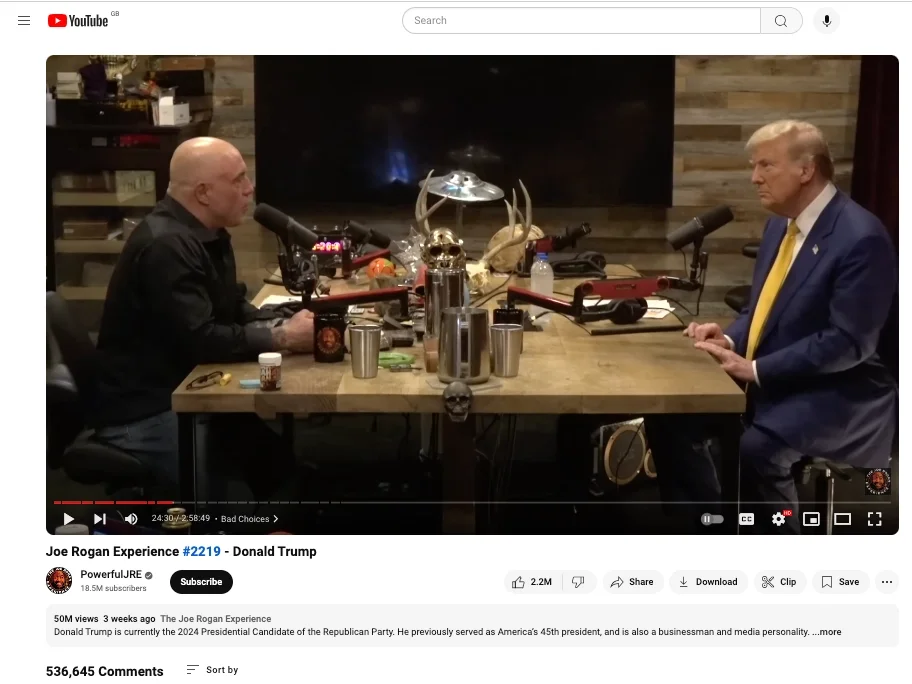
Just over a fifth of US adults now regularly get news from influencers on social media, a new Pew-Knight Initiative survey has found.
An analysis of who those influencers are indicated few of the most popular accounts for news online have ever formally worked in journalism and that they are more likely to lean right than left.
The findings come as the US media grapples with the result of the the 2024 presidential election and what it means for the reach and influence of professional journalism.
The survey, published on Monday, canvassed 10,658 US adults this summer and was weighted to be demographically representative of the US population.
Of those surveyed, 21% said they “regularly” get news from influencers. That figure rose to 37% among US adults aged 29 and below and 26% among those between 30 and 49.
Black, Hispanic and Asian Americans were more likely than the average US adult to regularly get news from influencers, at 27%, 30% and 29% respectively. Lower income Americans (26%) were the most likely socioeconomic bracket to get news this way and women (23%) were more likely to do so than men (19%).
Nearly two-thirds (65%) of Americans who said they got news from news influencers rated the content positively, saying it “helped them better understand current events and civic issues”.
About a quarter said it made little difference to their understanding of the world while 9% said it made them “more confused”. About six in ten (58%) said they follow or subscribe to at least one news influencer.
There was little difference between right-leaning (21%) and left-leaning (22%) people in how likely they were to get news from social media influencers – even though the influencers themselves were more likely to create right-leaning content.
[Read more: From James O’Brien to Joe Rogan — Rise of news influencers and alternative voices]
Top US news influencers are mostly male and lean right
As well as the survey, the Pew researchers looked at a sample of 500 “news influencers”, defined as individuals who had used news-related keywords in early 2024 who had a minimum of 100,000 followers. across X (formerly Twitter), Youtube, Instagram, Tiktok or Facebook.
Figures captured within the research included the likes of podcasters Joe Rogan and Felix Biederman, NYU journalism professor Jay Rosen, psychologist and Trump family member Mary L Trump, Twitch streamer Hasan Piker, journalists Piers Morgan, Megyn Kelly and Katie Couric, lawyer Alan Dershowitz and actress Alyssa Milano.
Less than a quarter (23%) of the news influencers sampled had ever worked for a news organisation. On X (formerly Twitter) the proportion of news influencers with ties to a news organisation rose to 26%, whereas on Youtube it fell to 12%.
Most of the 500 news influencers did not self-identify as right or left. Of those that did, 27% explicitly identified as Republican, conservative or supportive of Donald Trump and 21% as Democrats, liberal or Kamala Harris supporters.
The influencers who had worked in news were less likely to explicitly disclose a political orientation (with 64% staying unaligned, versus 44% of those without a traditional news affiliation), but those who did articulate a position were more likely to be right-leaning (25%) than left (9%).
Instagram was the most explicitly political platform for news influencers, with 55% of the creators there disclosing an orientation (30% right, 25% left). Although Facebook had a higher proportion of ostensibly unaligned news influencers, it also had the biggest proportion of right-leaning news influencers (39%, compared with 13% who were left-leaning).
Tiktok was the most left-leaning platform, with 28% of news influencers explicitly identifying themselves as left-leaning compared with 25% right-leaning.
Most (63%) of the news influencers assessed were men. Tiktok was the most gender-balanced platform, with 50% of the news influencers there men and 45% women. Youtube was the least balanced: 68% of the news influencers on the video platform were men versus 28% women.
X was the most used platform among news influencers, with 85% of the 500 assessed present there. Half had an Instagram account, 44% posted to Youtube, 32% to Facebook, 30% to Threads, 27% to Tiktok and 12% to Linkedin.
Of the 500 news influencers, 59% were monetising their presence. The most common way of doing this was through subscriptions (49%), with 29% accepting donations and 21% selling merchandise. The proportion monetising their accounts rose to 74% on Tiktok, 77% on Facebook and 80% on Youtube.
A third (34%) of the influencers also host a podcast and 22% have a newsletter.
The Pew research incorporated ChatGPT into its methodology. The chatbot was handed text and transcribed audio from the influencer accounts and asked to analyse the content to determine whether the influencers identified themselves, for example, as left or right. A human researcher then spot-checked 1% of the results to check they were accurate, and the error rate was included in the research.
Email pged@pressgazette.co.uk to point out mistakes, provide story tips or send in a letter for publication on our "Letters Page" blog
